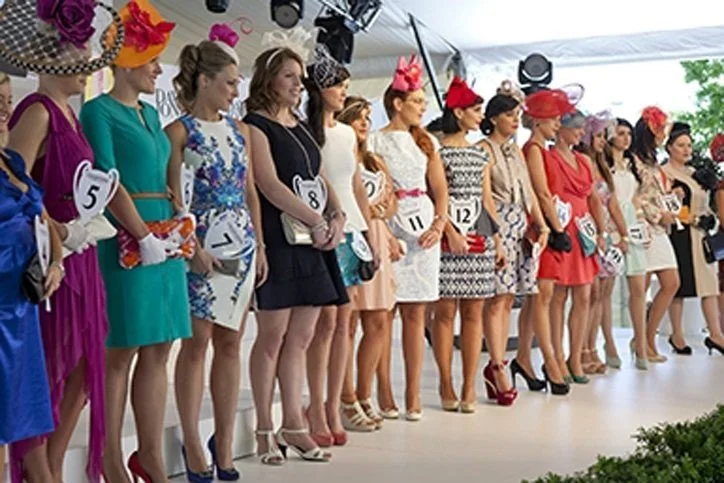Australian fashion rides Melbourne Cup to the winner's post
So, another Melbourne Cup has been run, and after weeks in lockdown, watching the colourful clothing of those attending made me curious – why did this event become so big……and when did the fashion aspect of this event take off?
Well, it turns out that it’s no accident that Australia’s biggest horse race developed in Melbourne. To mangle an analogy, the VRC had “means, motive and opportunity”[1]. The means was the wealth from the gold rushes, as well as the legal and economic structures to allow them to build a racecourse and related infrastructure. The opportunity was clearly there given the rapidly growing population and the cultural desire to gamble. As for motive, well, there’s a few.
The city’s frenetic growth was matched by stonemasons achieving an 8-hour working day law in 1856[2], (although it took much longer for this to become widespread), and the first shopping arcade in the city was built in 1853 . By the 1880s, Melbourne was one of the richest cities in the world, and society was (very) gradually becoming more progressive.
Much of the general public had both time and wealth to gamble on horses – and to dress up. At this time, fashion meant frock coats and hats for the gentlemen, and bonnets and bustles for the ladies.
1884 wood engraving of Cup fashions. Image: State Library Victoria. Image sourced from:
https://www.imagegroup.com.au/melbourne-cup-dress-code-wear-races-year/
It’s this social aspect that fascinates me, and it speaks to the Victorian (in both senses of the word) split personality. Horseracing provided an outlet for every part of society to enjoy something beyond everyday life. The Melbourne Cup (and related horse races elsewhere in Australia) also filled a social gap. In an era where reputation was so important, and social codes were rigid by today’s standards, the vast majority of women and men were not invited to debutante balls; from what I can tell, these were only open to the social elite. So, I think that the races allowed aspirational families to cross paths with people of higher social classes they’d otherwise have no chance to meet. In theory, young people would meet safely with chaperones…. but in practice, what better place would there be to “slip the leash” than a crowded racecourse?
Outside of the shopping arcades, I’d imagine much of colonial-era Melbourne was not a particularly safe place to be, especially for women, although maybe it would depend upon what class an individual belonged to. And yet, once a year, men and women would wear their finest clothes, and catch either the train or take a carriage out to Flemington. So far, so good…but then you are together with tens of thousands of people with different reasons to be at the race. I can’t help but imagine the place must have been absolutely heaving with thieves and pickpockets. Maybe everyone – thieves included – were more interested in gambling on the horses, and in having a good time?
How did the Melbourne Cup get so big?
Flemington Racecourse has existed since March 1840, when racing was moved out of the city to “Saltwater Flat” on the banks of the Maribyrnong River, with meetings held over three days[4]. A rail line was extended out to the racecourse in 1861[5], and the Melbourne Cup itself was established by Captain Frederick Charles Standish (1824-1883)[6].
The Victoria Racing Club (hereafter called the VRC) were determined to ensure that this race became the equivalent of anything seen in other nations. And why did this happen? Because Robert Cooper Bagot, the founding Secretary of the VRC, insisted that if racing were to prosper it must be made the sport of the ordinary citizen. Under his watch, the club established gardens, renovated the track, built a new grandstand seating 4000 people[7]; and offered its members free tickets for lady guests[8]. Bagot lobbied the Victorian Government and in 1866 the Government declared Cup Day a half-holiday for public servants and bank employees. In 1875 the Melbourne Cup was run for the first time on a Tuesday[9] and in 1877 became a general public holiday[10].
Before Bagot’s appointment, Flemington had never attracted a bigger crowd than 7000[11]. By 1873, attendance had risen to 63,000. And in 1880, 100,000 people made the journey to Flemington at a time when Melbourne’s population was only about 283,000[12].
Fashion moves from tradition to highlight
While people did like to dress up for the Melbourne Cup, it was secondary to the horse racing until a push in 1960 to ‘woo more women to the races’. This was so successful that in 1962 the Myer department store and the VRC collaborated to launch a ‘Fashions on the Field[13]’ competition to find ‘the smartest dressed woman’.
Flemington Racecourse 1968. Image sourced from https://www.thecultureconcept.com/melbourne-cup-evolving-fashions-on-the-field-150-years
By the 1980’s the fashion stakes increased dramatically. In 2018, the competition entered the digital age, with a photo-based competition for interstate contestants[14]. Today it is a national event and is marketed around the world. Throughout the year events are held across the country at race events to find finalists in the Women’s Racewear category interstate. The winners are then all flown to Melbourne to compete in the major competition held on Crown Oaks Day, traditionally now Women’s Day at the races in Melbourne[15].
What do you think - are horse racing and fashion a natural fit? Or has the VRC simply worked hard to create an event that works for both industries?
[1] https://www.oxfordreference.com/view/10.1093/oi/authority.20110803100145785
[2] https://www.nma.gov.au/defining-moments/resources/eight-hour-day
[3] Page 79, https://apo.org.au/sites/default/files/resource-files/2016-06/apo-nid212981.pdf
[4] https://shawfactor.com/reference/flemington-racecourse-history/
[5] https://en.wikipedia.org/wiki/Melbourne_and_Essendon_Railway_Company
[6] https://www.thecultureconcept.com/melbourne-cup-a-race-stopping-all-australia-in-its-tracks
[7] https://sahof.org.au/hall-of-fame-member/robert-bagot/
[8] https://www.vrc.com.au/about-vrc/the-history-of-the-vrc/
[9] https://www.racingvictoria.com.au/the-sport/racing/australian-racing-museum/hall-of-fame/associates/robert-cooper-bagot
[10] https://www.thecultureconcept.com/melbourne-cup-the-race-that-stops-the-nation-in-its-tracks
[11] https://adb.anu.edu.au/biography/bagot-robert-cooper-2916
[12] https://sahof.org.au/hall-of-fame-member/robert-bagot/
[13] https://www.imagegroup.com.au/melbourne-cup-dress-code-wear-races-year
[14] https://10play.com.au/melbourne-cup-carnival-fashion/articles/myer-fashion-on-the-field-history/tpa201104ojrwv
[15] https://www.thecultureconcept.com/melbourne-cup-evolving-fashions-on-the-field-150-years








